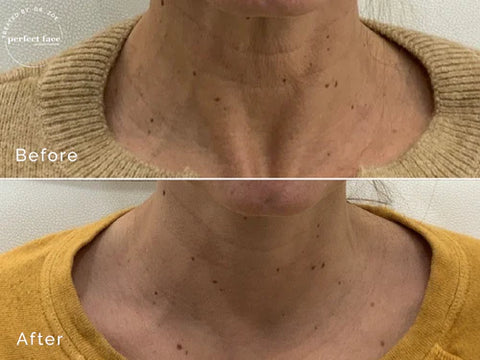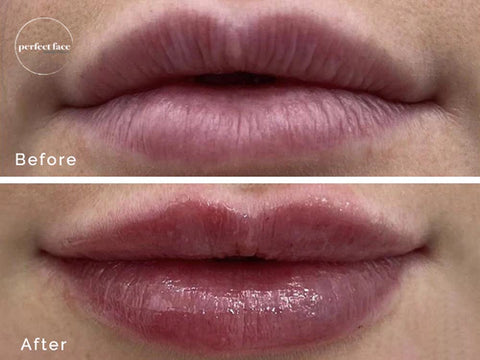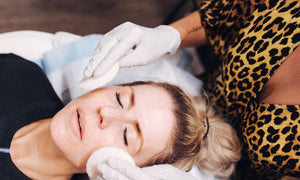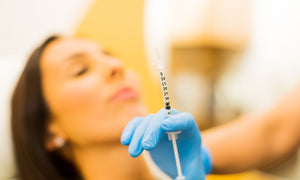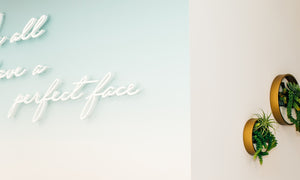Are you a Botox connoisseur, but still hesitant to dip into the power of fillers?
What’s interesting to me is that filler has been around for 20 years and has evolved even more so than wrinkle relaxers such as Botox. For example, there are now a variety of viscosities of filler that lend well to specific areas of the face that need more movement. What’s even more exciting is that the range and applications of filler are so sophisticated, no one ever has to know. Based on the extensive research about aging that we have today, Botox and filler truly need each other in the journey to maintaining and regaining your most natural youthful appearance.
Aging skin is multidimensional. Thus, your toolbox for addressing aging skin should be multidimensional too. Read on to learn about how tackling aging by reducing and preventing wrinkles (Botox), but failing to support facial structure (with filler), is somewhat like painting a building without the help of scaffolding. Here’s a bit about why most of us need BOTH…
Filler and Botox are besties that (often) bring out the best in each other!
Botox relaxes dynamic wrinkles, whereas fillers smooth out static wrinkles, support and restore lost volume, and help sculpt your best youthful-looking contours and definition. Need I say more about why one can be ‘lost without the other’?
I received my first filler treatment around 10 years ago, in my early 30s. At that time, things were rudimentary compared to the level of knowledge, scientific literature, and product selection that we have today. One of the most popular chief complaints in aesthetics is nasolabial folds (NLFs) or ‘smile lines’. Gone are the days that you would sit down and just have some filler pushed into these folds. Now, we know (and have evidence) that NLFs are a symptom caused by the changes of an aging face. Now that we know better, we can do better and we can achieve better results - striking the perfect combination that tackles wrinkling and volume loss. How lucky are we?!
Treating the Aging Face From ‘Inside Out’
Let’s take a minute to think about the progression of the aging face from the “inside out’: the bony skeleton platform to the skin envelope.¹
1. BONE
We progressively lose bone density starting in our 30s to 50s contributing to loss of structural support, definition and stability of the overlying skin and soft tissues. This is where the ‘landslide’ begins. Bony resorption (aka loss) typically starts in the maxilla (the bony support of our midface) and extends to loss of mandibular support (affecting the jawline and chin). Orbital bone loss leads to deeper tear troughs and smaller looking eyes. Even small changes in the bony support of the face can cause dramatic effects in the outward signs of aging.
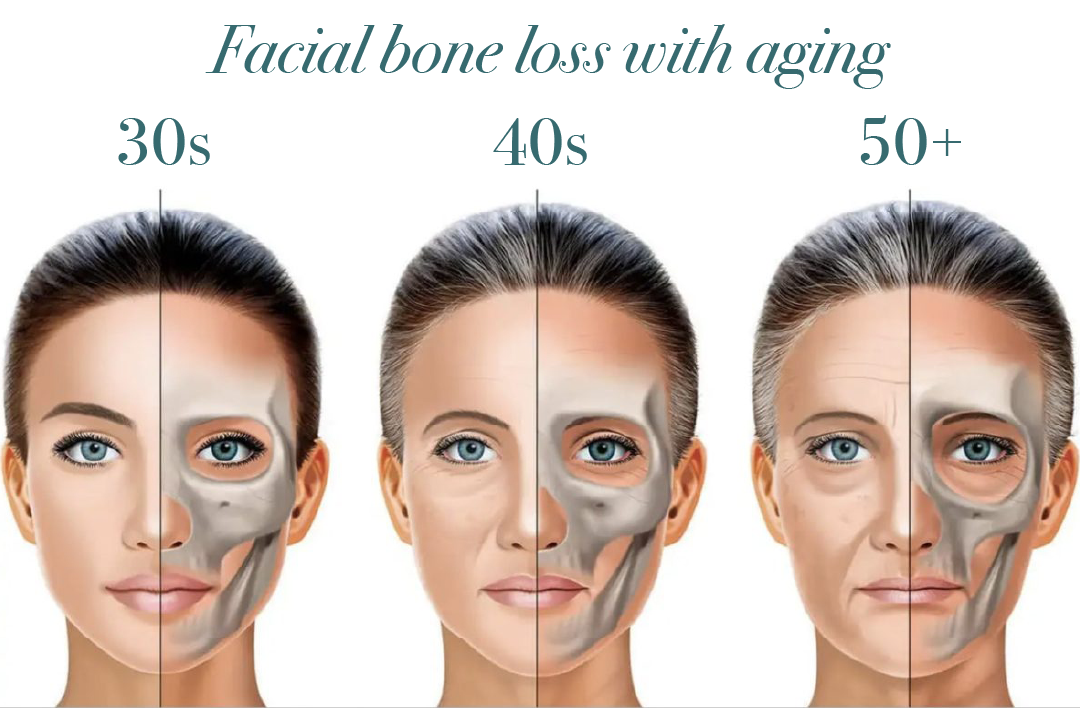
How filler can be used to counteract bone loss:
You can think of fillers as coming in a variety of ‘strengths’, each with their own measurements of lifting capacity and cohesivity (a measure of their flexibility/stretch capacity). A strong filler, such as Juvederm Volux, can be used deep near bone to mimic the support offered by bone. For example, in the jawline Volux can provide projection and definition, restoring the sculpted jawline of youth. In the chin, Volux can provide projection and length to a shortened and receding chin.
2. FAT
We have superficial and deep fat pads lying on top of our bony platform. Facial fat is responsible for a youthful face shape and contour. Again, beginning in our 30s to 50s, fat pads end up being repositioned, typically downward and inward causing hollowing in the cheek, flattening of facial angles and even temporal hollowing. The majority of the facial fat pads also decrease in size as we age. However, some pesky ones increase. Namely the jowl fat and nasolabial fat (how cruel!).
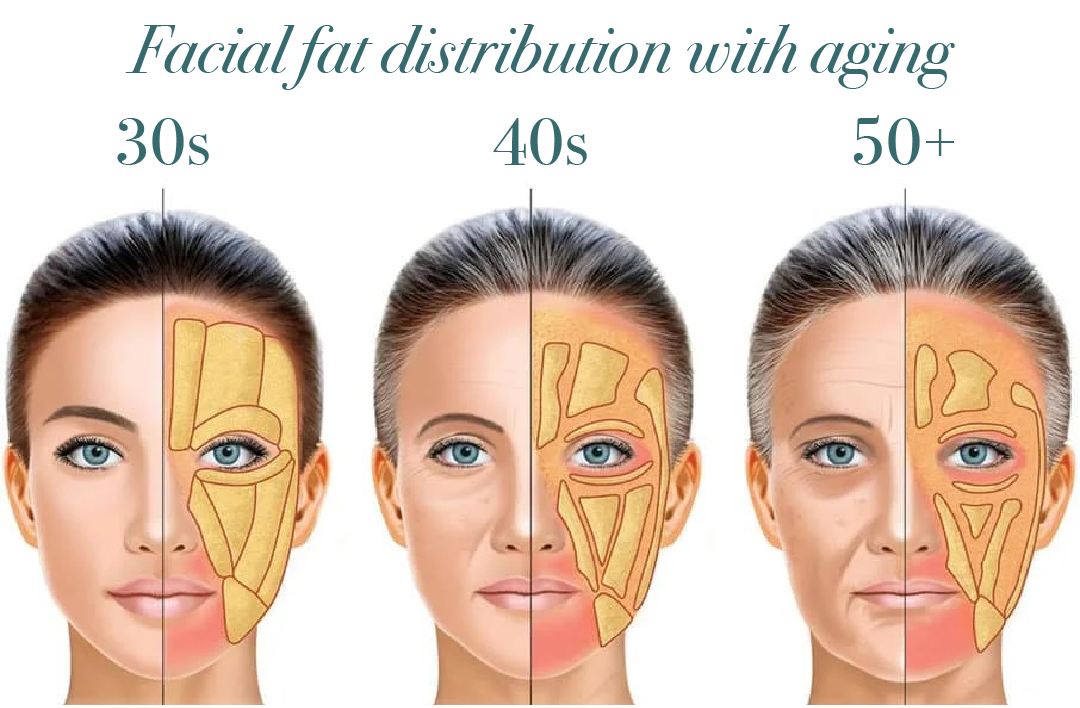
How filler can be used to counteract repositioning and shrinking of fat pads:
More dynamic fillers such as Restylane Contour, Revance RHA 3 or 4, can be used in the mid face to mimic fat loss, replenishing the superficial and deep fat pads. The stretchy but strong characteristics of these fillers are sought after in this area to help preserve natural facial movement and expression. Restoration of midface volume with filler is one example of an ‘indirect’ treatment approach to improving nasolabial folds.
3. MUSCLE
We all know repetitive muscle contraction leads to ‘dynamic’ wrinkles which as time passes eventually become ‘static’ or resting wrinkles. A newer concept called ‘dynamic discord with aging’ refers to the relationship between muscles and aging skin. Most muscles decrease in strength as we age, however the skin ages faster and is much less resistant to the stressors of the underlying muscle. The result? Hyperdynamic expressions. Think ‘chin cellulite’, perioral wrinkles, and platysma bands in the neck.

How filler can be used to counteract muscle changes:
Softer, thinner fillers such as Revance Rednesity, Juvederm Vollure, or Restylane Refyne can be used in the more superficial layers of the skin (often with cannula technique) to achieve myomodulation. This is a phenomenon whereby the placement of filler either increases or decreases muscle activity. For example, placement of filler deep in the pyriform aperture to soften a gummy smile. Another example is placement of filler in strategic areas around the mouth to help soften a resting ‘sad’ frown face and dimpling of the chin.
4. SKIN
The changes here we know all too well. Intrinsic (the passing of time) and extrinsic (environmental) causes of aging contribute to thinner, less elastic, less bright, more hyperpigmented, and more visible vascularity. The loss of collagen and elastin begins in our 20s and is responsible for many of these changes.
How filler can be used to improve skin integrity:
Hyaluronic acid gel fillers such as Juvederm Volbella, Skinvive and Revance Redensity along with biostimulatory type injectables (ex: Radiesse) can add hydration and improve integrity of the skin itself. The latter even promotes new growth of collagen, leading to skin tightening and wrinkle reduction over time.
Now that you understand the major factors in facial aging, the why, let’s move on to talk about the what, the how and all the other most common filler-associated questions.
FAQs About Filler
Can I get Botox and filler at the same time?
Sure can! Botox is very commonly performed in the same treatment as filler, and they very much complement one another. Through the use of botox and filler, we can achieve incredibly natural transformations without the need for surgery or other more invasive treatments. Using Botox and fillers together can prolong the results of treatment, and address multiple areas of the face simultaneously for the most natural looking results.
What are the types of fillers?
Two big categories here:
- Hyaluronic acid gel fillers (often called HAs) …these fillers are not all created alike, and your educated injector will know how to use each to their best potential. Examples: Juvderm Voluma/Volux/Volbella, Restylane Lyft/Kysse/Defyne/Refyne, Revance RHA + Rednesity
- Biostimulatory injectables (It’s really a misnomer to call these ‘fillers’ since this type triggers your own collagen.) Examples: Sculptra and Radiesse
What kind of filler do I need?
Your educated provider will know best. There are dozens of brands of filler . Within each brand, there are many categories with varying properties that make them preferable for one facial area over another, for example. Today, you should expect your provider to take the time to do a full face assessment addressing the areas of the face that are causing the areas of concern. When your aging is more well understood, your treatment plan will be tailored to you, and your results will look natural. For a complimentary consult, book with us today.
How is filler injected?
Filler may be injected with a needle or a cannula. A cannula is a long, blunt needle that can help to decrease bruising and lower the risk of adverse events associated with filler.
How painful is a filler treatment? How can I lessen the discomfort of filler?
Pain is subjective! Many of my clients tell me that filler causes much less discomfort for them than even Botox does. We do have options on our Comfort Menu that range from topical/injectable anesthesia to giggle gas.
What are the risks of filler?
While mostly safe, there are of course risk and adverse events that can occur such as:
-Redness
-Swelling
-Tenderness
-Lumps and Bumps
-Infection
-Vascular occlusion
The good news is that side effects of filler are either self-limited or can be addressed with proper post-treatment care. Your provider should be notified immediately if you experience any serious side-effects so that assessment and treatment can be performed expeditiously.
How long does filler last?
The short answer is it depends on the area and the person. In general, anywhere from 6 months to 2 years (plus!). Areas that move more, may need more frequent maintenance treatments to maintain results. For example, lip filler and filler around the mouth may require treatment every 6 months - 18 months. Whereas midface/cheek filler typically is 18 months-2 years.
How should I prepare for filler?:
- In order to decrease the risk of bruising you should avoid Aspirin, NSAIDs (Motrin), and fish oil supplements for 1 week prior to treatment.
- Arnica pellets can also be taken by mouth a few days before to help lower the risk of bruising. Arnica can also help expedite recovery by decreasing inflammation and duration of bruising if it does develop.
- If you have an active infection, postpone your filler.
- Dental work should be avoided 2 weeks before and 2 weeks after filler, as should timing of vaccinations.
- Tell your provider if you have any allergies, allergic symptoms, and autoimmune disorders.
- Tell your provider if you have a history of cold sores.
How much does filler cost?
That’s not an easy answer! In Europe, ‘per area’ pricing for filler is extremely common. For example, $2000 for midface or $1500 for lips. In the US, it’s much more common to see ‘per syringe’ pricing of filler. The important thing to remember here is that you aren’t paying for the gel in the syringe, you’re paying for your provider’s skillset and artistry, their experience, their dedication to ongoing education and their ability to use that syringe in the best way that suits you. At PFAM, we offer filler packages as well as a VIP Membership called ‘The Perfect Vault’ to help bring down the ‘per syringe’ price of filler for those addressing multiple areas, or receiving multiple syringes in one sitting. The range of syringe pricing is $775-950 depending on the filler type.
What’s the downtime with filler?
Anytime a needle enters skin, there is a risk of a bruise. On average, bruising can take up to 2 weeks or more to fully resolve. Mild swelling is typically present, depending on the area, for about a week afterwards. I always say you don’t love or hate your filler for a month. The reason being, you have an immediate result from filler but it’s not your ‘final result’. Swelling and bruising needs to subside and filler integrates with the natural tissues to give you that final result around week 3-4. If you have an event or an important social obligation, I recommend scheduling your filler appointment at least 2-4 weeks beforehand.
Will I look overdone? How much filler is too much?
These days, even just a short scroll on IG and you’ll definitely find some celeb that looks overdone, unnatural or plain old weird. It’s important to remember that these celebrities are not getting this look from a single treatment, and surely not a single syringe of filler. Let’s start with a quick calculation of how much good ‘supportive’ fat we lose in our face as we age. Starting in our 30s we begin to lose about a teaspoon of this good facial fat every year. Now for a simple math equation: 5 syringes of filler is equivalent to one teaspoon. Imagine if you’re a first time filler client at age 50, even 4 syringes of filler (less than a ketchup packet!) will hardly begin to replace the support that’s been lost. As a second example, consider a 30-something who starts getting a small amount of filler annually to help replace the loss of fat and support that is starting to occur. My approach to clients when treating with filler is strategic placement with anti-aging goals in mind. Replacing only what has been lost, not augmenting the face and creating contours and shapes that were never natural.
Get Started With Filler
Check out my other blogs, Facial Balancing, Perfect Jawline Treatments, and The Lip Guide. Whether you’re all set to try filler for the first time, or combine it with Botox at your next appointment, or if you’re a bit unsure, book a consultation and we can explore your options for a more youthful and refreshed YOU, together.
¹ Arthur Swift, MD, Steven Liew, MD, Susan Weinkle, MD, Julie K Garcia, PhD, Michael B Silberberg, MD, MBA (2020): “The Facial Aging Process From the “Inside Out”


